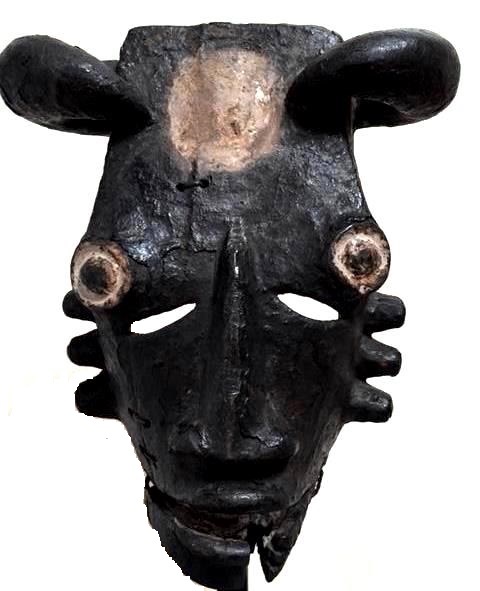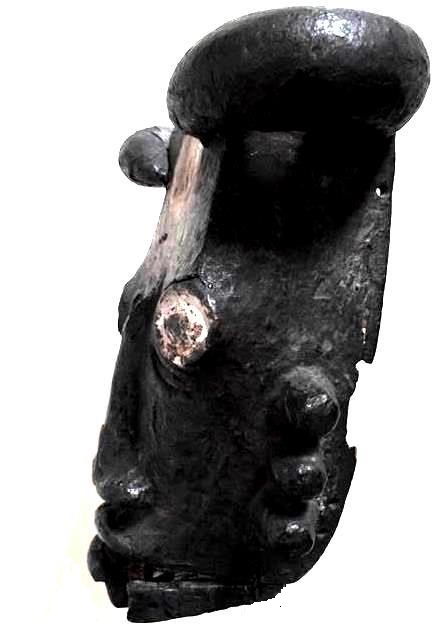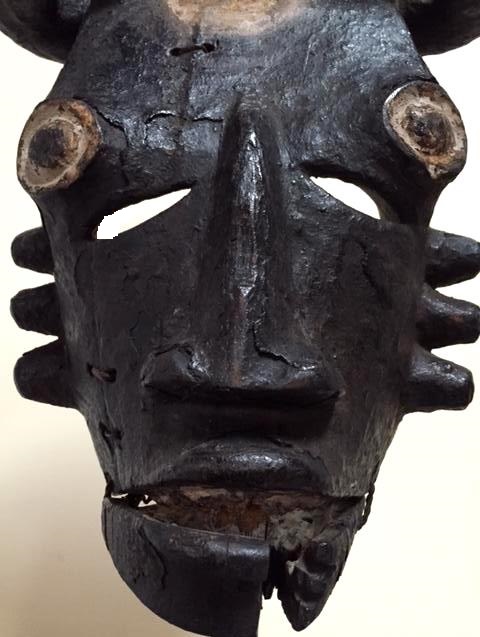Ogoni (Kana) people, Karipko Mask, Niger Delta, Nigeria
Pagina 1 di 1
 Ogoni (Kana) people, Karipko Mask, Niger Delta, Nigeria
Ogoni (Kana) people, Karipko Mask, Niger Delta, Nigeria

Ogoni (Kana) people, Karipko Mask, Niger Delta, Nigeria
Wood, crusty patina of long use, kaolin and vegetable fibers, pigments color
H. 12,6 in / cm 33
End of 19th century
Private collection, Italy
Arti delle Mani Nere All Rights Reserved
Provenance
Edward Klejman coll. Parigi
Denise and Beppe Berna coll. Bologna
Private coll. Milano
The mask was collected by Edward Klejman in the 60s and even a cursory looks very old, very used, with all the typical signs of a long and fond of using, as the tribal restoration which has been submitted. Collected in Nigeria by Klajman in a border village of population Ogoni with Ibibio, in the Niger Delta, the mask can be attributed to Ogoni (Kana), even if we can find artistic influences of Ibibio / Anang (see Masks mfon ekpo ).
This ancient mask, called Karipko, was linked to the practices of the propitiatory agricultural cycles as well as the management of special events surrounding the village. Used by young acrobatic dancers who performed at the sound of a sacred drum, expression was propitiatory fertility and fortitude.
As you can see, the element zoomorphic with those bulging eyes side coated with kaolin and horns confluent on the top, are predominant elements of sculpture, almost identifying elements. But try to brighten eyes at the center of the mask: the two slots on the bias at the top, where it begins the beautiful nose … immediately zoomorphic element disappears to make the vision of a powerful and expressive human face ending in the mobile jaw restrained by ties made of plant matter, typical of Ogoni culture. The anthropomorphic element takes over and the whole expression, first animal, is now anthropomorphic.


How not to ask questions?
First. Those two cracks are only the result of the need to wear the mask, as structural elements to ensure the vision of the young dancing? No, because it would explain the apparent intention of a humanoid face with distinct features such as the mighty nose and mouth, with the maxillary part even of small teeth carved.
Second. Conversely it was prevalent in the artist’s intention anthropomorphic. None, because the eyes globular put so stressed and the presence of horns exclude de facto this intentionality.
Third. The artist, as in many other cases have made a synthesis of elements of animal and human as is often found in many forms, not only in Nigeria, but also, for example, the Ivory Coast: I think of the four forms of the rite Goli.
No, not even this explanation is unsatisfactory because in this picture there are no animals and human elements in toto! In this mask coexist in harmony, but well divided and separated element is that the zoomorphic anthropomorphic … just watch the mask in the first globular eyes and looks into the cracks and then the buffalo central … the animal disappears to make way for a pure human facial expression, expressive on the verge of brutality. der And this poses serious problems of interpretation in my opinion, beyond the mask and invest, unlike both the meanings aesthetic / expressive, but also symbolic / hieratic.

Articulate in such a unique entity both animal and human is the expression of a high synthesis of thought that goes beyond the intentions plastic / artistic to assume, on the contrary a phenomenal wealth of imagination in which the synthesis of human / animal is achieved, but with respect for autonomous prerogatives and peculiarities.

As if the mask intends to emphasize a common ancient origin of the two entities, which then, however, the evolution in the course of its millennial path discriminated, making humans and animals two entities distinct though in some ways complementary to each other. And this complementarity if for us, western people, has practically disappeared, for Ogoni culture and for the unknown artist who carved the mask is on the contrary well immanent, since the life of man, for that culture and for that society, not It is separated from that of the animal.
This mask, which to my knowledge is unicum artistic celebrates both the complexity of a refined thinking through a ‘artistic expression of rare evocative power.
Bibliography
-Talbot, P.A., "In Ju-Ju Land, Where Flowers Were Shot Down From Trees and Python-guarded Lake of the Dead is Sacred." The Illustrated London News, 1912
-Talbot, P.A “In the Shadow of the Bush”, Heinemann ed., London, 1912
-Jones, G. I. "The Art of Eastern Nigeria", Cambridge: Cambridge University Press, 1984.
-Neyt, F.- Désirant, A. “ Les Arts de la Benue aux racines des traditions” Editions Hawaiian Agronomics, Belgique, 1985
-AA.VV. “ Arts du Nigeria”, Réunion des Musées nationaux, Parigi, 1997
-Berns, M.C., Fardon, R., Kasfir, S.L and AA.VV “ Central Nigeria Unmasked: Arts of Benue River Valley”, Fowles Museum at Ucla, Los Angeles, 2011
Ogoni (Kana) people. Karipko Mask, Niger Delta, Nigeria
Legno, patina crostosa di lungo utilizzo, caolino e fibre vegetali, pigmenti colore
H. 12,6 in / cm 33
Fine 19th secolo
La maschera è stata raccolta da Edward Klejman negli anni ’60 e da una pur sommaria valutazione appare molto vecchia, molto usata, con tutti quei segni tipici di un prolungato ed affezionato utilizzo, come dimostrano i restauri tribali alla quale è stata sottoposta.
Raccolta in Nigeria da Klajman in un villaggio di confine della popolazione Ogoni (Kana) con quella degli Ibibio, nel delta del Niger, la maschera è ascrivibile, in ogni caso, alla popolazione Ogoni seppure siano presenti influenze artistiche degli Ibibio/Anang ( v. maschere mfon ekpo).
Questa antica maschera, denominata karipko, era collegata alle pratiche propiziatorie dei cicli agricoli oltre che alla gestione di particolari eventi riguardanti il villaggio. Utilizzata da giovani danzatori acrobatici che si esibivano al suono di un sacro tamburo, era espressione propiziatoria di fertilità e di forza d’animo.
Come si può notare, l’elemento zoomorfo con quegli sporgenti occhi laterali rivestiti di caolino e le corna confluenti sulla sommità, sono gli elementi preponderanti della scultura, direi quasi quasi, gli elementi identificativi.

Ma si provi ad illuminare gli occhi posti al centro della maschera: le due fessure di sbieco, in alto, dove inizia il bellissimo naso…immediatamente l’elemento zoomorfo scompare per lasciare la visione di un potente ed espressivo viso umano che termina con quella mandibola mobile trattenuta da legacci fatti di elementi vegetali, tipica della cultura Ogoni.

L’elemento antropomorfo ha il sopravvento e l’intera espressività, prima animale, è adesso antropomorfa.
Come non porsi interrogativi.
Primo. Quelle due fessure sono soltanto l’esito della necessità di indossare la maschera, cioè puri elementi strutturali per garantire la visione del giovane danzante?
No perché non si spiegherebbe la manifesta intenzionalità di un volto con spiccate caratteristiche umanoidi quali il possente naso e la bocca, dotata nella parte mascellare perfino di piccoli denti scolpiti.
Secondo. Viceversa, era prevalente nell’artista l’intenzione antropomorfa. Nemmeno, perché gli occhi globulari messi così in risalto e la presenza di corna escludono de facto questa intenzionalità.
Terzo. L’artista, come in tanti altri casi ha realizzato una sintesi di elementi animali ed umani come spesso si rileva in tante maschere non soltanto nigeriane, ma anche, per esempio della Costa d’Avorio e mi vengono in mente le quattro maschere del rito Goli.
No, nemmeno questa spiegazione è soddisfacente perché in questa maschera non sono presenti elementi animali ed umani tout-court! In questa maschera convivono in armonia, ma ben divisi e separati sia l’elemento zoomorfo che quello antropomorfo…è sufficiente guardare la maschera prima negli occhi globulari ed appare il bufalo e poi nelle fessure centrali…l’animale scompare, per lasciare il posto ad una pura espressione facciale umana, espressiva al limite della brutalità.
E questo pone a mio parere seri problemi interpretativi, che esulano dalla maschera ed investono, al contrario sia i significati estetico/espressivi, ma anche quelli simbolico/ieratici.
Articolare in un unicum siffatto le due entità animali ed umane è espressione di una elevata sintesi di pensiero che travalica le intenzioni plastico/artistiche per ipotizzare, al contrario, una ricchezza immaginativa fenomenale, nella quale la sintesi uomo/animale si realizza, ma nel rispetto delle autonome prerogative e peculiarità.
Come se la maschera intenda sottolineare una comune antica origine delle due entità che poi, però, l’evoluzione nel corso del suo millenario percorso ha discriminato, rendendo uomo e animale due entità ben distinte anche se per certi versi complementari l’una dell’altra.
E questa complementarietà se per noi occidentale è praticamente scomparsa, per la cultura Ogoni e per l’ignoto artista che anticamente ha scolpito la maschera è al contrario ben immanente, dal momento che la vita dell’uomo, per quella cultura e per quella società, non poteva di fatto prescindere da quella dell’animale.

Questa maschera, che a mia conoscenza costituisce un unicum artistico celebra insieme la complessità di un raffinato pensiero attraverso l’espressione artistica di una rara potenza evocativa.

 Argomenti simili
Argomenti simili» Ekoi/ Ejagham people, Ekpe society, Skin-covered wood mask headdress, Nigeria, Cross River Region
» Landuman people, Thönköngba or Numbe mask, Guinea
» Pende people, Mbuya mask Kwago Area, Congo
» Yaka people, Kholuka mask, Democratic Republic of Congo
» Senufo people, Kpeli-Yehe mask, Ivory Coast
» Landuman people, Thönköngba or Numbe mask, Guinea
» Pende people, Mbuya mask Kwago Area, Congo
» Yaka people, Kholuka mask, Democratic Republic of Congo
» Senufo people, Kpeli-Yehe mask, Ivory Coast
Pagina 1 di 1
Permessi in questa sezione del forum:
Non puoi rispondere agli argomenti in questo forum.
 Indice
Indice